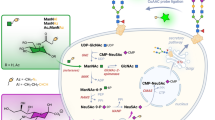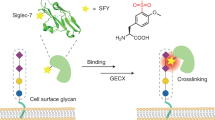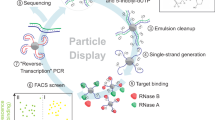Abstract
The N-acetyl-D-mannosamine (ManNAc) analog Ac5ManNTGc, a non-natural metabolic precursor for the sialic acid biosynthetic pathway, can be used to display thiols on the cell surface. Sugar-expressed cell-surface thiols are readily accessible compared to their protein counterparts, making them ideal for exploitation in cell-adhesion and tissue-engineering applications. This report describes a protocol for the incubation of Jurkat (human acute T-cell leukemia) cells with Ac5ManNTGc and the quantitative estimation of the resulting sialic acid displayed thiols by flow cytometry after a reaction with a water-soluble biotin-conjugated maleimide reagent and fluorescein isothiocyanate-conjugated (FITC) avidin staining. These methods, with minimal optimization, are generally also applicable to other human cell lines. The labeling and flow cytometry steps of this protocol can be performed in five to eight hours.
This is a preview of subscription content, access via your institution
Access options
Subscribe to this journal
Receive 12 print issues and online access
$259.00 per year
only $21.58 per issue
Buy this article
- Purchase on Springer Link
- Instant access to full article PDF
Prices may be subject to local taxes which are calculated during checkout







Similar content being viewed by others
References
Angata, T. & Varki, A. Chemical diversity in the sialic acids and related α-keto acids: an evolutionary perspective. Chem. Rev. 102, 439–469 (2002).
Tanner, M.E. The enzymes of sialic acid biosynthesis. Bioorg. Chem. 33, 216–228 (2005).
Kayser, H. et al. Biosynthesis of a nonphysiological sialic acid in different rat organs, using N-propanoyl-d-hexosamines as precursors. J. Biol. Chem. 267, 16934–16938 (1992).
Keppler, O.T., Horstkorte, R., Pawlita, M., Schmidt, C. & Reutter, W. Biochemical engineering of the N-acyl side chain of sialic acid: biological implications. Glycobiology 11, 11R–18R (2001).
Yarema, K.J. New directions in carbohydrate engineering: a metabolic substrate-based approach to modify the cell surface display of sialic acids. BioTechniques 31, 384–393 (2001).
Goon, S. & Bertozzi, C.R. Metabolic substrate engineering as a tool for glycobiology. J. Carbohydr. Chem. 21, 943–977 (2002).
Dube, D.H. & Bertozzi, C.R. Metabolic oligosaccharide engineering as a tool for glycobiology. Curr. Opin. Chem. Biol. 7, 616–625 (2003).
Mahal, L.K., Yarema, K.J. & Bertozzi, C.R. Engineering chemical reactivity on cell surfaces through oligosaccharide biosynthesis. Science 276, 1125–1128 (1997).
Jacobs, C.L. et al. Substrate specificity of the sialic acid biosynthetic pathway. Biochemistry 40, 12864–12874 (2001).
Collins, B.E., Fralich, T.J., Itonori, S., Ichikawa, Y. & Schnaar, R.L. Conversion of cellular sialic acid expression from N-acetyl- to N-glycolylneuraminic acid using a synthetic precursor, N-glycolylmannosamine pentaacetate: inhibition of myelin-associated glycoprotein binding to neural cells. Glycobiology 10, 11–20 (2000).
Saxon, E. & Bertozzi, C.R. Cell surface engineering by a modified Staudinger reaction. Science 287, 2007–2010 (2000).
Lemieux, G.A. & Bertozzi, C.R. Chemoselective ligation reactions with proteins, oligosaccharides and cells. Trends Biotechnol. 16, 506–513 (1998).
Prescher, J.A. & Bertozzi, C.R. Chemistry in living systems. Nat. Chem. Biol. 1, 13–21 (2005).
Nauman, D.A. & Bertozzi, C.R. Kinetic parameters for small-molecule drug delivery by covalent cell surface targeting. Biochim. Biophys. Acta 1568, 147–154 (2001).
Lee, J.H. et al. Engineering novel cell surface receptors for virus-mediated gene transfer. J. Biol. Chem. 274, 21878–21884 (1999).
Iwasaki, Y., Tabata, E., Kurita, K. & Akiyoshi, K. Selective cell attachment to a biomimetic polymer surface through the recognition of cell-surface tags. Bioconjug. Chem. 16, 567–575 (2005).
Prescher, J.A., Dube, D.H. & Bertozzi, C.R. Chemical remodelling of cell surfaces in living animals. Nature 430, 873–877 (2004).
Sampathkumar, S.-G., Li, A.V., Jones, M.B., Sun, Z. & Yarema, K.J. Metabolic installation of thiols into sialic acid modulates adhesion and stem cell biology. Nat. Chem. Biol. 2, 149–152 (2006).
Sampathkumar, S.-G., Li, A.V. & Yarema, K.J. Synthesis of non-natural ManNAc analogs for the expression of thiols on cell surface sialic acids. Nat. Protocols (in the press).
Howarth, M. & Ting, A.Y. Giving cells a new sugar-coating. Nat. Chem. Biol. 2, 127–128 (2006).
Sarkar, A.K., Fritz, T.A., Taylor, W.H. & Esko, J.D. Disaccharide uptake and priming in animal cells: inhibition of sialyl Lewis X by acetylated Gal β1,4GalcNAc β-Onaphthalenemethanol. Proc. Natl. Acad. Sci. USA 92, 3323–3327 (1995).
Jones, M.B. et al. Characterization of the cellular uptake and metabolic conversion of acetylated N-acetylmannosamine (ManNAc) analogues to sialic acids. Biotechnol. Bioeng. 85, 394–405 (2004).
Yarema, K.J., Mahal, L.K., Bruehl, R.E., Rodriguez, E.C. & Bertozzi, C.R. Metabolic delivery of ketone groups to sialic acid residues. Application to cell surface glycoform engineering. J. Biol. Chem. 273, 31168–31179 (1998).
Jacobs, C.L. et al. Metabolic labeling of glycoproteins with chemical tags through unnatural sialic acid biosynthesis. Meth. Enzymol. 327, 260–275 (2000).
Sahaf, B., Heydari, K., Herzenberg, L.A. & Herzenberg, L.A. Lymphocyte surface thiol levels. Proc. Natl. Acad. Sci. USA 100, 4001–4005 (2003).
Getz, E.B., Xiao, M., Chakrabarty, T., Cooke, R. & Selvin, P.R. A comparison between the sulfhydryl reductants tris(2-carboxyethy)phosphine and dithiothreitol for use in protein biochemistry. Anal. Biochem. 273, 73–80 (1999).
Kim, E.J., Jones, M.B., Rhee, J.K., Sampathkumar, S.-G. & Yarema, K.J. Establishment of N-acetylmannosamine (ManNAc) analogue-resistant cell lines as improved hosts for sialic acid engineering applications. Biotechnol. Prog. 20, 1674–1682 (2004).
Kim, E.J . et al. Characterization of the metabolic flux and apoptotic effects of O-hydroxyl- and N-acetylmannosamine (ManNAc) analogs in Jurkat (human T-lymphoma-derived) cells. J. Biol. Chem. 279, 18342–18352 (2004).
Martin, M.J., Muotri, A., Gage, F. & Varki, A. Human embryonic stem cells express an immunogenic nonhuman sialic acid. Nat. Med. 11, 228–232 (2005).
Barbosa, J.N., Barbosaa, M.A. & Águas, A.P. Inflammatory responses and cell adhesion to self-assembled monolayers of alkanethiolates on gold. Biomaterials 25, 2557–2563 (2004).
Nam, Y., Chang, J.C., Wheeler, B.C. & Brewer, G.J. Gold-coated microelectrode array with thiol linked self-assembled monolayers for engineering neuronal cultures. IEEE Trans. Biomed. Eng. 51, 158–165 (2004).
Turner, N., Armitage, M., Butler, R. & Ireland, G. An in vitro model to evaluate cell adhesion to metals used in implantation shows significant differences between palladium and gold or platinum. Cell Biol. Int. 28, 541–547 (2004).
Yousaf, M.N., Houseman, B.T. & Mrksich, M. Using electroactive substrates to pattern the attachment of two different cell populations. Proc. Natl. Acad. Sci. USA 98, 5992–5996 (2001).
Mrksich, M. What can surface chemistry do for cell biology? Curr. Opin. Chem. Biol. 6, 794–797 (2002).
Liu, T., Guo, Z., Yang, Q., Sad, S. & Jennings, H.J. Biochemical engineering of surface α2,8 polysialic acid for immunotargeting tumor cells. J. Biol. Chem. 275, 32832–32836 (2000).
Lemieux, G.A., Yarema, K.J., Jacobs, C.L. & Bertozzi, C.R. Exploiting differences in sialoside expression for selective targeting of MRI contrast reagents. J. Am. Chem. Soc. 121, 4278–4279 (1999).
De Bank, P.A., Kellam, B., Kendall, D.A. & Shakesheff, K.M. Surface engineering of living myoblasts via selective periodate oxidation. Biotechnol. Bioeng. 81, 800–808 (2003).
Yarema, K.J. in Cell Engineering 3. Glycosylation Vol. 3 (ed. Al-Rubeai, M.) 171–196 (Kluwer Academic Publishers, Dordrecht, 2002).
Garige, M., Gong, M., Rao, M.N., Zhang, Y. & Lakshmana, M.R. Mechanism of action of ethanol in the down-regulation of Galβ1,4GlcNAc α2,6-sialyltransferase messenger RNA in human liver cell lines. Metabolism 54, 729–734 (2005).
Marmillot, P., Rao, M.N., Liu, Q.H. & Lakshman, M.R. Chronic ethanol increases ganglioside sialidase activity in rat leukocytes, erythrocytes, and brain synaptosomes. Alcohol Clin. Exp. Res. 23, 376–380 (1999).
dos Santos, A., Rodrigues, M., Alviano, C. & de Araujo Soares, R. Changes of sialomolecules during the dimethylsulfoxide-induced differentiation of Herpetomonas samuelpessoai. Parasitol. Res. 88, 951–955 (2002).
Mantey, L.R., Keppler, O.T., Pawlita, M., Reutter, W. & Hinderlich, S. Efficient biochemical engineering of cellular sialic acids using an unphysiological sialic acid precursor in cells lacking UDP-N-acetylglucosamine 2-epimerase. FEBS Lett. 503, 80–84 (2001).
Yarema, K.J., Goon, S. & Bertozzi, C.R. Metabolic selection of glycosylation defects in human cells. Nat. Biotechnol. 19, 553–558 (2001).
Luchansky, S.J., Yarema, K.J., Takahashi, S. & Bertozzi, C.R. GlcNAc 2-epimerase can serve a catabolic role in sialic acid metabolism. J. Biol. Chem. 278, 8036–8042 (2003).
Villavicencio-Lorini, P., Laabs, S., Danker, K., Reutter, W. & Horstkorte, R. Biochemical engineering of the acyl side chain of sialic acids stimulates integrin-dependent adhesion of HL60 cells to fibronectin. J. Mol. Med. 80, 671–677 (2002).
Editorial. Biology and brimstone. Nat. Chem. Biol. 2, 169 (2006).
Hogg, P.J. Disulfide bonds as switches for protein function. Trends Biochem. Sci. 28, 210–214 (2003).
Nakashima, I. et al. Redox-linked signal transduction pathways for protein tyrosine kinase activation. Antioxid. & Redox Signal. 4, 517–531 (2002).
Sahaf, B., Heydari, K., Herzenberg, L.A. & Herzenberg, L.A. The extracellular microenvironment plays a key role in regulating the redox status of cell surface proteins in HIV-infected subjects. Arch. Biochem. Biophys. 434, 26–32 (2005).
Ghetie, V. & Vitetta, E.S. Chemical construction of immunotoxins. Mol. Biotechnol. 18, 251–268 (2001).
Hakomori, S.-I. The glycosynapse. Proc. Natl. Acad. Sci. USA 99, 225–232 (2002).
Han, S., Collins, B.E., Bengtson, P. & Paulson, J.C. Homo-multimeric complexes of CD22 revealed by in situ photoaffinity protein-glycan crosslinking. Nat. Chem. Biol. 1, 93–97 (2005).
Acknowledgements
We are grateful to K. Konstantopoulos for flow cytometer access, P. Pawar for technical assistance in FACS experiments, J.D. Gearhart and M. J. Shamblott for the kind gift of hEBD-LVEC cells, T.H. Wang for a kind gift of QD655–streptavidin conjugate, and J.M. McCaffery and E. Perkins of Integrated Imaging Facility (Johns Hopkins University, Department of Biology) for help with confocal microscopy. Funding was provided by the Arnold and Mabel Beckman Foundation, the US National Institutes of Health (1R01CA112314-01A1) and the National Science Foundation (QSB-0425668).
Author information
Authors and Affiliations
Corresponding author
Ethics declarations
Competing interests
The authors declare no competing financial interests.
Rights and permissions
About this article
Cite this article
Sampathkumar, SG., Jones, M. & Yarema, K. Metabolic expression of thiol-derivatized sialic acids on the cell surface and their quantitative estimation by flow cytometry. Nat Protoc 1, 1840–1851 (2006). https://doi.org/10.1038/nprot.2006.252
Published:
Issue Date:
DOI: https://doi.org/10.1038/nprot.2006.252
This article is cited by
-
Metabolic glycan labelling for cancer-targeted therapy
Nature Chemistry (2020)
-
Cellular metabolism of unnatural sialic acid precursors
Glycoconjugate Journal (2015)
-
Synthesis of non-natural ManNAc analogs for the expression of thiols on cell-surface sialic acids
Nature Protocols (2006)
Comments
By submitting a comment you agree to abide by our Terms and Community Guidelines. If you find something abusive or that does not comply with our terms or guidelines please flag it as inappropriate.



